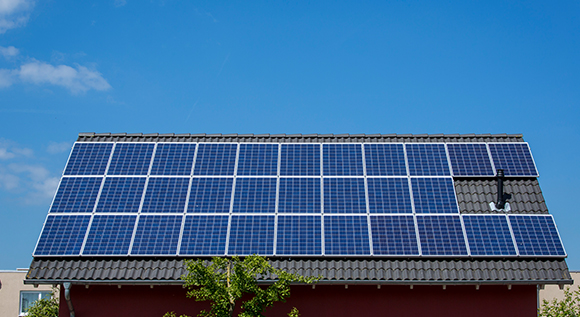Solar energy can be stored
When the mid-day sun shines brightly, the solar installations get busy feeding electricity into the grid. But what if the grid can hardly cope at times of peak production? The re-launch of the battery-storage programme is good news for the grids and provides funding for more solar power to be stored.
 © BMWi /Holger Vonderlind
© BMWi /Holger Vonderlind
In future, government funding will only be available for battery-storage systems if these help to ease the burden on the grid. This means that they need to act like a bouncer in front of a nightclub – they must make sure that there is never too much electricity entering the grid. How exactly does this work?
Imagine blue skies, not a cloud in sight. The roof-top installations are operating at full capacity. Now, if all solar installations were to feed this power into the grid, this could soon result in overloading. The programme is there to prevent this from happening. From now on, funding for battery-storage systems will only be provided for installations that throttle the maximum capacity of the solar installation to which they are connected, bringing it down to 50 per cent. The battery will then store the excess electricity for the time being. Later, when there is little or no solar energy being generated, the electricity stored by the battery can be used to power machinery or home appliances, such as washing machines, hairdryers or TV sets. This makes it possible for those operating the systems to use a higher share of the electricity they produce and reduces the amount they have to buy.
Promoting a responsible use of renewable energy
The new programme launched by the Federal Ministry for Economic Affairs and Energy and KfW on 1 March encourages greater flexibility when it comes to feeding power from PV installations, thus stabilising our electricity supply. In doing so, it also promotes greater responsibility around the use of renewables. This is necessary, given that the task of integrating ever-growing amounts of solar and wind power into the market has proved to be one of the biggest challenges associated with the energy transition. There were more than 1.5 million PV installations feeding power into German distribution grids last year, and that number is growing.
The new programme marks the beginning of a second round of funding provided for the use of battery-storage systems. Its precursor, under which co-financing for more than 19,000 installations of this type was provided from May 2013 on (that's two out of three of all PV battery-storage systems installed in Germany) expired at the end of 2015. The total funding of approx. €60 million was able to leverage seven times as much in investment (some €450 million).
The new PV battery-storage programme: who can receive funding?
The new programme benefits private individuals, freelancers and businesses who invest in battery storage for PV installations connected to the grid. Funding comes in the form of repayment grants issued by KfW.
Let's take an example: Let's assume that the net price of a small-scale PV storage system with a capacity of five kilowatt (5 kWp being the PV installation's maximum feed-in capacity) is €13,000. As we calculate the amount of funding, we first deduct the cost of the PV installation, which is €8,000. This leaves us with €5,000 for the battery-storage system, for which an application for funding can be filed. As of today, you would be entitled to a repayment grant of €1,250, which corresponds to 25 per cent of the cost of the investment. The total amount of funding provided under the programme up to the end of 2018 is €30 million.
Apart from the requirement for the storage system to throttle the PV installations feed-in capacity by 50 per cent, there is another change compared to the old programme: the level of funding will be adjusted to account for any past or future drops in the prices of battery-storage system. For this reason, the amount of funding is incrementally reduced each semester, starting at 25 per cent of the investment (just like in the example).

